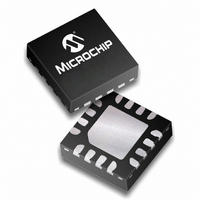PIC16F688-E/ML Microchip Technology, PIC16F688-E/ML Datasheet - Page 271

PIC16F688-E/ML
Manufacturer Part Number
PIC16F688-E/ML
Description
IC PIC MCU FLASH 4KX14 16QFN
Manufacturer
Microchip Technology
Series
PIC® 16Fr
Datasheets
1.PIC16F616T-ISL.pdf
(8 pages)
2.PIC16F688T-ISL.pdf
(204 pages)
3.PIC16F688T-ISL.pdf
(6 pages)
4.PIC16F688T-ISL.pdf
(4 pages)
5.PIC16F688T-ISL.pdf
(688 pages)
Specifications of PIC16F688-E/ML
Core Size
8-Bit
Program Memory Size
7KB (4K x 14)
Core Processor
PIC
Speed
20MHz
Connectivity
UART/USART
Peripherals
Brown-out Detect/Reset, POR, WDT
Number Of I /o
12
Program Memory Type
FLASH
Eeprom Size
256 x 8
Ram Size
256 x 8
Voltage - Supply (vcc/vdd)
2 V ~ 5.5 V
Data Converters
A/D 8x10b
Oscillator Type
Internal
Operating Temperature
-40°C ~ 125°C
Package / Case
16-QFN
Controller Family/series
PIC16F
No. Of I/o's
12
Eeprom Memory Size
256Byte
Ram Memory Size
256Byte
Cpu Speed
20MHz
No. Of Timers
2
Processor Series
PIC16F
Core
PIC
Data Bus Width
8 bit
Data Ram Size
256 B
Interface Type
EUSART, RS- 232, SCI, USB
Maximum Clock Frequency
20 MHz
Number Of Programmable I/os
12
Number Of Timers
2
Maximum Operating Temperature
+ 125 C
Mounting Style
SMD/SMT
3rd Party Development Tools
52715-96, 52716-328, 52717-734
Development Tools By Supplier
PG164130, DV164035, DV244005, DV164005, PG164120, ICE2000, DM163014, DM164120-4
Minimum Operating Temperature
- 40 C
On-chip Adc
10 bit, 8 Channel
Lead Free Status / RoHS Status
Lead free / RoHS Compliant
For Use With
AC164324 - MODULE SKT FOR MPLAB 8DFN/16QFNXLT16QFN1 - SOCKET TRANSITION 14DIP TO 16QFNAC162061 - HEADER INTRFC MPLAB ICD2 20PINAC162056 - HEADER INTERFACE ICD2 16F688
Lead Free Status / Rohs Status
Details
- PIC16F616T-ISL PDF datasheet
- PIC16F688T-ISL PDF datasheet #2
- PIC16F688T-ISL PDF datasheet #3
- PIC16F688T-ISL PDF datasheet #4
- PIC16F688T-ISL PDF datasheet #5
- Current page: 271 of 688
- Download datasheet (3Mb)
16.4.2
16.4.3
1997 Microchip Technology Inc.
Master Mode (Firmware)
Multi-Master Mode (Firmware)
Master mode of operation is supported by interrupt generation on the detection of the START and
STOP conditions. The STOP (P) and START (S) bits are cleared from a reset or when the SSP
module is disabled. Control of the I
with both the S and P bits clear.
In master mode the SCL and SDA lines are manipulated by clearing the corresponding TRIS
bit(s). The output level is always low, irrespective of the value(s) in PORT. So when transmitting
data, a '1' data bit must have the TRIS bit set (input) and a '0' data bit must have the TRIS bit
cleared (output). The same scenario is true for the SCL line with the TRIS bit.
The following events will cause the SSPIF Interrupt Flag bit to be set (SSP Interrupt if enabled):
• START condition
• STOP condition
• Data transfer byte transmitted/received
Master mode of operation can be done with either the slave mode idle (SSPM3:SSPM0 = 1011)
or with the slave active (SSPM3:SSP0 = 1110 or 1111). When the slave modes are enabled, the
software needs to differentiate the source(s) of the interrupt.
In multi-master mode, the interrupt generation on the detection of the START and STOP condi-
tions allows the determination of when the bus is free. The STOP (P) and START (S) bits are
cleared from a reset or when the SSP module is disabled. Control of the I
when the P bit (SSPSTAT<4>) is set, or the bus is idle with both the S and P bits clear. When the
bus is busy, enabling the SSP Interrupt will generate the interrupt when the STOP condition
occurs.
In multi-master operation, the SDA line must be monitored to see if the signal level is the
expected output level. This check only needs to be done when a high level is output. If a high level
is expected and a low level is present, the device needs to release the SDA and SCL lines (set
the TRIS bits). There are two stages where this arbitration can be lost, they are:
• Address Transfer
• Data Transfer
When the slave logic is enabled, the slave continues to receive. If arbitration was lost during the
address transfer stage, communication to the device may be in progress. If addressed an ACK
pulse will be generated. If arbitration was lost during the data transfer stage, the device will need
to re-transfer the data at a later time.
2
C bus may be taken when the P bit is set, or the bus is idle
Section 16. BSSP
2
DS31016A-page 16-21
C bus may be taken
16
Related parts for PIC16F688-E/ML
Image
Part Number
Description
Manufacturer
Datasheet
Request
R

Part Number:
Description:
Manufacturer:
Microchip Technology Inc.
Datasheet:

Part Number:
Description:
IC PIC MCU FLASH 4KX14 14SOIC
Manufacturer:
Microchip Technology
Datasheet:

Part Number:
Description:
IC MCU FLASH 4KX14 14TSSOP
Manufacturer:
Microchip Technology
Datasheet:

Part Number:
Description:
IC PIC MCU FLASH 4KX14 14DIP
Manufacturer:
Microchip Technology
Datasheet:

Part Number:
Description:
IC PIC MCU FLASH 4KX14 16QFN
Manufacturer:
Microchip Technology
Datasheet:

Part Number:
Description:
IC MCU PIC FLASH 4KX14 14SOIC
Manufacturer:
Microchip Technology
Datasheet:

Part Number:
Description:
IC PIC MCU FLASH 4KX14 14TSSOP
Manufacturer:
Microchip Technology
Datasheet:

Part Number:
Description:
IC MCU PIC FLASH 4KX14 14DIP
Manufacturer:
Microchip Technology
Datasheet:

Part Number:
Description:
IC PIC MCU FLASH 4KX14 14TSSOP
Manufacturer:
Microchip Technology
Datasheet:

Part Number:
Description:
IC, 8BIT MCU, PIC16F, 32MHZ, SOIC-18
Manufacturer:
Microchip Technology
Datasheet:

Part Number:
Description:
IC, 8BIT MCU, PIC16F, 32MHZ, SSOP-20
Manufacturer:
Microchip Technology
Datasheet:

Part Number:
Description:
IC, 8BIT MCU, PIC16F, 32MHZ, DIP-18
Manufacturer:
Microchip Technology
Datasheet:

Part Number:
Description:
IC, 8BIT MCU, PIC16F, 32MHZ, QFN-28
Manufacturer:
Microchip Technology
Datasheet:

Part Number:
Description:
IC, 8BIT MCU, PIC16F, 32MHZ, QFN-28
Manufacturer:
Microchip Technology
Datasheet:

Part Number:
Description:
IC, 8BIT MCU, PIC16F, 32MHZ, QFN-28
Manufacturer:
Microchip Technology
Datasheet:










